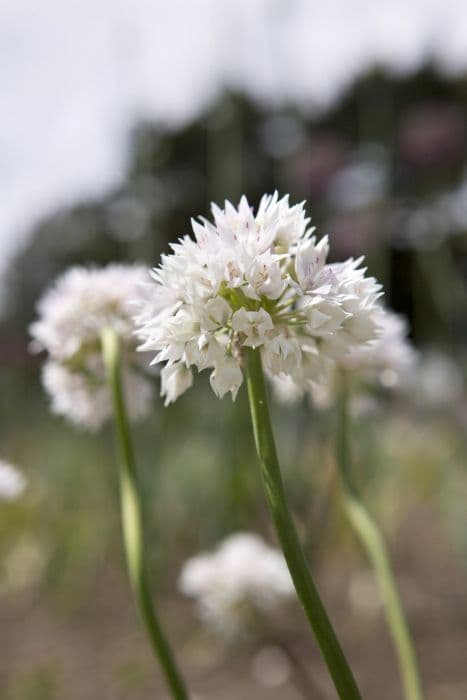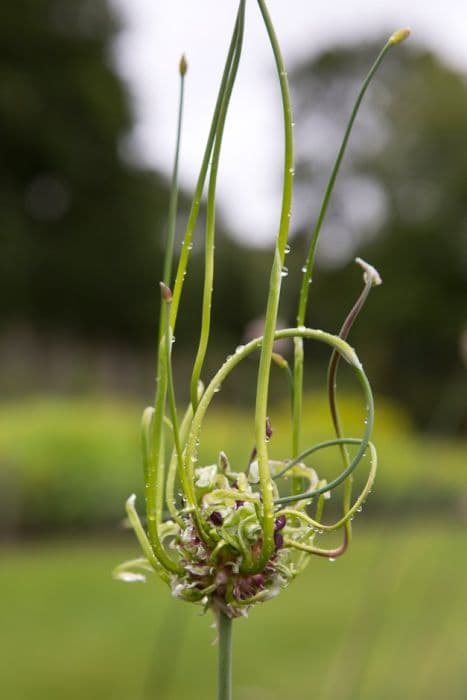Siberian chives Allium nutans

ABOUT
Allium nutans, commonly known as Siberian chives, is a plant characterized by its graceful, nodding flowers and lush clumps of foliage. This plant features slender leaves that are vivid green and have a slight glossiness, growing in a tufted fashion. The leaves are typically elongated, with a smooth texture and pointed ends, emanating a subtle onion-like fragrance when crushed. The flowers of Siberian chives sit atop elongated stems, forming an umbrella-like cluster referred to as an umbel. Each umbel consists of several individual star-shaped flowers. These blooms are often a soft pink to rose-purple shade, creating a delicate visual display. The petals on each flower are symmetrically arranged around the center, which may be slightly more pronounced or have a different hue, adding depth to the overall floral formation. The structure of the inflorescence gives the plant a soft, drooping appearance, which is why it has earned the name "nutans," implying a nodding gesture. This aesthetic feature adds a sense of movement and elegance to the plant's profile. The flowers typically blossom in the warmer months, providing a seasonal spectacle of color. Additionally, Siberian chives also produce bulb-like structures at the base, which are concealed beneath the soil, these contribute to the plant's resilience and perennial nature. With its attractive foliage and charming flowers, Allium nutans brings a unique beauty to gardens, borders, and as a component in wildflower collections. Its ability to adapt to various soil conditions makes it a versatile addition to many landscaping designs without reference to its specific size dimensions.
About this plant
 Names
NamesFamily
Amaryllidaceae
Synonyms
Siberian Chives, Blue Chives, Ornamental Onion
Common names
Allium nutans subsp. nutans, Allium nutans var. nutaliensis, Allium nutans subsp. nutaliensis, Allium subvillosum, Allium nutans var. senescens, Allium senescens var. nutans, Allium suworowii, Allium tataricum var. nutans.
 Toxicity
ToxicityTo humans
Allium nutans, commonly known as Siberian chives, is not considered highly toxic to humans. Generally, members of the Allium family, which includes onions, garlic, and chives, are edible and used in many cuisines. However, some people may have sensitivities or allergies to these plants, which could cause adverse reactions such as gastrointestinal upset, skin irritation, or in rare cases, anaphylaxis. It is important to note that excessive consumption of Allium species can potentially lead to hemolytic anemia, though this is more of a concern for pets than humans.
To pets
Siberian chives, known scientifically as Allium nutans, can be toxic to pets such as cats and dogs if ingested. Members of the Allium family (including onions, garlic, chives, and leeks) contain compounds that can lead to oxidative damage to red blood cells in pets, causing a condition known as hemolytic anemia. Symptoms of poisoning may include lethargy, weakness, reduced appetite, pale gums, and red urine. In severe cases, ingestion can lead to organ damage or even be fatal if not treated promptly. Pet owners should avoid feeding their animals any part of these plants or foods seasoned with them.
 Characteristics
CharacteristicsLife cycle
Perennials
Foliage type
Deciduous
Color of leaves
Green
Flower color
Pink
Height
1-2 feet (30-60 cm)
Spread
1 foot (30 cm)
Plant type
Bulb
Hardiness zones
4
Native area
Asia
Benefits
 General Benefits
General Benefits- Edible Parts: The leaves and flowers of Siberian chives can be used in salads, as a garnish, or to add a mild onion flavor to dishes.
- Aesthetic Appeal: Siberian chives feature attractive pink or purple blossoms that can add a splash of color to gardens and attract pollinators such as bees and butterflies.
- Low Maintenance: Siberian chives are known for being hardy and requiring minimal care, making them suitable for both experienced and novice gardeners.
- Culinary Uses: The plant is often used as a herb in cooking, providing a subtle garlic-like flavor to a variety of recipes.
- Companion Planting: Siberian chives can be planted alongside other vegetables as they are believed to help repel certain pests and enhance the growth of companion plants.
 Medical Properties
Medical Properties- Antimicrobial: Allium nutans has been noted for its antimicrobial properties, which might help in fighting against bacteria and fungi.
- Antioxidant: This plant contains compounds that may have antioxidant effects, neutralizing free radicals in the body.
- Cardiovascular health: It may contribute to cardiovascular health due to its potential effect on blood pressure and cholesterol levels.
- Anti-inflammatory: Allium nutans may possess anti-inflammatory agents that could help reduce inflammation throughout the body.
- Gastrointestinal health: It has been traditionally used to aid in digestion and to help relieve gastrointestinal issues.
- Immune system support: Components of this plant could help support the immune system, potentially aiding the body's defense mechanisms.
- Respiratory health: It has been used historically to help treat respiratory conditions such as colds and coughs.
 Air-purifying Qualities
Air-purifying QualitiesThis plant is not specifically known for air purifying qualities.
 Other Uses
Other Uses- Allium nutans flowers can be used as a natural dye, imparting a range of colors to textiles depending on the mordant used.
- The seed heads of Siberian chives may be dried and used in floral arrangements or as an ornamental feature in crafts.
- The fibrous leaves of Siberian chives can be used in basket weaving or as a natural string for garden use.
- Siberian chives can serve as a companion plant in gardens, reportedly deterring certain pests like aphids and enhancing the growth of roses.
- These plants can be used in permaculture design as a perennial border that requires minimal maintenance.
- The plant's robust flavor makes Siberian chives a unique herb for infusing oils and vinegars in culinary applications.
- Siberian chives, when planted densely, can provide ground cover and help suppress weeds in garden beds or around other crops.
- The plant's leaves can be turned into a natural insect repellent by crushing and extracting their juice.
- Siberian chives' strong scent is sometimes used to mask other odors in a compost heap or among other stronger-smelling plants.
- Brewing a plant tea from Siberian chives is sometimes used by gardeners as a foliar spray to provide nutrients and potentially ward off some fungal diseases.
Interesting Facts
 Feng Shui
Feng ShuiThe Allium nutans, commonly known as Siberian chives, is not used in Feng Shui practice.
 Zodiac Sign Compitability
Zodiac Sign CompitabilityThe Siberian chives is not used in astrology practice.
 Plant Symbolism
Plant Symbolism- Longevity: The Allium nutans, commonly known as Siberian chives, has a life cycle that returns year after year, symbolizing longevity and endurance in various cultures.
- Prosperity: With its robust growth and abundance of flowers, Siberian chives can represent prosperity and abundance.
- Good Fortune: Many allium species are believed to bring good luck, possibly due to their spherical clusters of flowers that can symbolize completeness and perfection.
- Unity: The tight clusters of the small flowers in the Allium nutans' bloom can symbolize unity and togetherness in a community or family.
- Protection: Traditionally, alliums, including Siberian chives, were thought to have protective properties, warding off evil spirits and bad luck when planted in a garden or worn as talismans.
 Water
WaterSiberian chives should be watered deeply once a week, ensuring the soil is moist but not waterlogged. During the growing season, it may require more frequent watering, especially if the weather is particularly hot or dry. Typically, applying about one to two gallons of water per square yard per week should be sufficient. Adjustments may be necessary depending on rainfall and temperature fluctuations. Always check the top inch of soil for dryness before watering again.
 Light
LightSiberian chives thrive in full sun, so placing them in a spot that receives at least six hours of direct sunlight is ideal. These plants can tolerate partial shade, but for best growth and flowering, choose a sunny location. Avoid deeply shaded areas to prevent weak and leggy growth.
 Temperature
TemperatureSiberian chives prefer moderate temperatures and grow best between 55°F and 75°F. They can tolerate temperatures as low as 40°F and as high as 85°F without severe damage. It's important to protect the plant from extreme heat or cold to maintain optimal health and growth.
 Pruning
PruningPrune Siberian chives to remove spent flower heads and encourage a denser, tidier appearance. Trimming can be done periodically throughout the growing season as needed. The best time for thorough pruning is in early spring or after the plant has finished flowering, to rejuvenate the plant for future growth.
 Cleaning
CleaningAs needed
 Soil
SoilSiberian chives prefer well-draining soil rich in organic matter with a pH range of 6.0 to 7.0. A mix of garden soil, compost, and sand in equal parts works well for container growing to ensure sufficient drainage and fertility.
 Repotting
RepottingSiberian chives don't require frequent repotting; they should be repotted every 2-3 years or when the clumps become overcrowded to maintain vigorous growth.
 Humidity & Misting
Humidity & MistingSiberian chives are adaptable to a wide range of humidity levels and generally do well in average garden conditions without the need for specific humidity adjustments.
 Suitable locations
Suitable locationsIndoor
Place Siberian chives near a sunny window and water regularly.
Outdoor
Plant Siberian chives in full sun to partial shade with good soil.
Hardiness zone
4-9 USDA
 Life cycle
Life cycleAllium nutans, commonly known as Siberian chives, starts its life cycle as a seed that germinates in the soil when temperature and moisture conditions are favorable. Upon germination, it develops a root system and shoots that push through the soil surface, transitioning into a seedling stage. As it matures, this perennial herb grows into a clump with narrow, elongated leaves and begins the vegetative growth stage, where it focuses on accumulating resources and developing its bulb. In late spring or early summer, Siberian chives enter the reproductive stage, producing tall stalks topped with umbels of typically lavender or pinkish flowers which attract pollinators. After pollination, flowers develop into seed capsules, and once seeds mature, they are dispersed by wind or wildlife to start a new generation. Throughout its life, Allium nutans may also reproduce vegetatively by division of its bulbous base, effectively expanding its clonal colonies.
 Propogation
PropogationPropogation time
Spring-summer
The Siberian chives (Allium nutans) are commonly propagated through division, which is best done in the spring or early fall. To propagate by division, carefully dig up established clumps and gently separate the bulbs by hand, ensuring that each new section has at least one bulb with attached roots and foliage. Replant the divisions immediately at the same depth they were originally growing, spacing them about 6 to 8 inches (15 to 20 centimeters) apart to allow for proper growth and air circulation. This method is straightforward and usually results in robust new plants that will continue to mature and multiply over time, providing a generous supply of the plant for both culinary and ornamental use.








